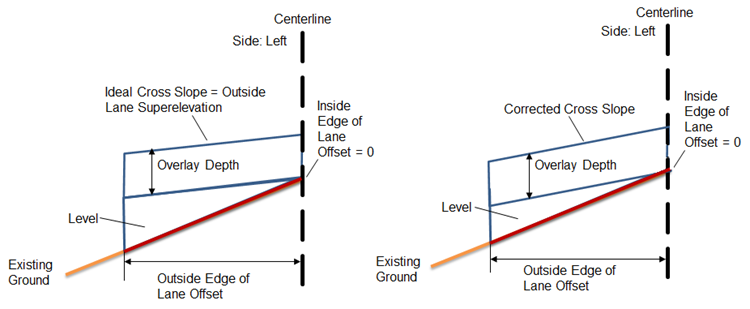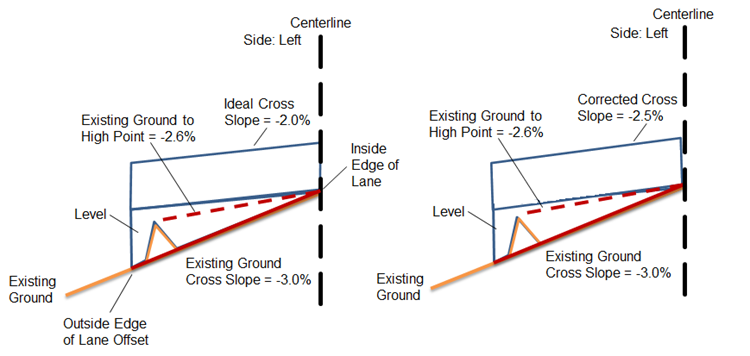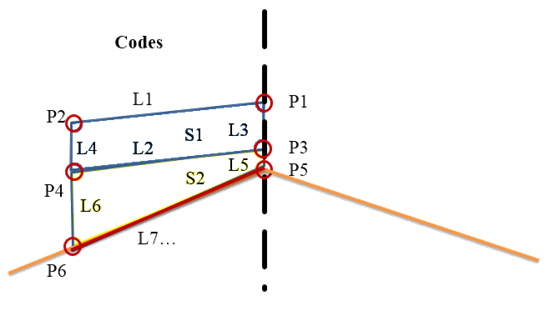This subassembly overlays one side of an existing roadway, with a leveling layer added as required.
Attachment
The attachment point is the inside edge point of the overlay layer with finished grade cross slope.
Input Parameters
Note: All dimensions are in meters or feet unless otherwise noted. All slopes are in run-over-rise form (for example, 4:1) unless indicated as a percent slope with a "%" sign.
| Parameter
|
Description
|
Type
|
Default
|
|---|
| Side
|
Specifies which side of the road centerline to place the subassembly.
|
Left/Right
|
Right
|
| Overlay Depth
|
Depth of the overlay layer.
|
Numeric
|
0.300m (0.300 ft)
|
| Design Lane Width same as Existing Lane Width
|
- Yes
Specifies that the design lane width is the same as existing lane width.
- No
Specifies that the design lane width
is not the same as existing lane width.
Note: If No is selected, the Inside Edge of Existing Lane and Outside Edge of Existing Lane parameters will not be applied to the subassembly.
|
User defined
|
No
|
| Inside Edge of Existing Lane
|
This is the start point for calculating existing ground slope.
|
Numeric
|
0.000m (0.000 ft)
|
| Outside Edge of Existing Lane
|
This is the end point for calculating existing ground slope.
|
Numeric
|
12.000m (12.000 ft)
|
| Overlay Slope Options
|
Specifies overlay slope options.
Tip: Flapping is a term used to describe how the corrected cross slope for an overlay in a rehab subassembly is calculated. Flapping outcomes are different, relative to the slope tolerance and the slope difference between existing ground cross slope and ideal cross slope. If the slope difference is less than the slope tolerance for the subassembly, then the use case is considered "within tolerance". If the slope difference is greater than the slope tolerance for the subassembly, then the use case is considered "outside of tolerance."
Note: Slope tolerance is an absolute value. Therefore, for either a slope difference of 0.4% or -0.4%, both have an absolute value of 0.4%. If the slope tolerance is 0.5%, the 0.4% absolute slope difference would be considered within tolerance.
|
User Defined
|
Match slope
|
| Ideal Cross Slope
|
Specifies user-defined ideal cross slope.
|
Numeric
|
-2.00%
|
| Lane Width
|
The lane width, determined by the offset of the outside edge of lane from the inside edge of lane.
|
Numeric
|
0.000m (0.000 ft)
|
| Use Profile Options
|
Select to tie the inside edge of the overlay layer to a profile, adjust elevation to minimum level depth, or lock to previous subassembly.
- Minimum Level Depth
The cross slope and elevation adjustments will meet Minimum Level and/or Minimum Mill Depth. The base is the existing surface.
- Use Profile
There will be no elevation adjustment. The elevation of the rehab subassembly attachment point will match the assigned profile. The cross slope adjustment will be determined by Overlay Slope Options.
- Lock to Previous
There will be no elevation adjustment. The elevation of the rehab subassembly attachment point will match the attachment point of the previous subassembly (in most cases this will be the previous lane's end point). The cross slope adjustment will be determined by Overlay Slope Options.
|
User defined
|
Minimum Level Depth
|
| Minimum Level Depth
|
The minimum level depth between the existing surface and the bottom of the overlay layer.
|
Numeric
|
0.300m (0.300 ft)
|
| Slope Tolerance
|
The amount that the overlay cross slope is allowed to vary from the existing ground cross slope or the ideal cross slope.
|
Numeric, positive
|
0.50%
|
Flapping

Note: Flapping outcomes are different, relative to the Slope Tolerance and the Slope Difference between existing ground cross slope and ideal cross slope.
Inside Edge of Lane Offset
Lock to Previous 1
In this use case the second lane is set to use the Lock to Previous option. The attachment point for Lane 2 will lock to the elevation of the end of Lane 1. The level depth at the start of the second lane is greater than the minimum level depth specified for that lane.
The corrected cross slope will be calculated and applied, but no elevation adjustment or flapping will be applied. In some cases, the minimum level depth might not be met.
Lock to Previous 2
In this use case the second lane is set to use the Lock to Previous option. The attachment point for Lane 2 will lock to the subassembly of Lane 1. The level depth at the start of the second lane is less than minimum level depth specified for that lane.
The corrected cross slope will be calculated and applied, but no elevation adjustment or flapping will be applied. In some cases, the minimum level depth might not be met.
Outside Lane Superelevation
The ideal cross slope is equal to the outside lane superelevation.

Note: A superelevation table for the alignment is required to read these values. Superelevation values will be read from the superelevation table for the alignment.
Output Parameters
| Parameter
|
Description
|
Type
|
Default
|
|---|
| Corrected Cross Slope
|
This is the adjusted cross slope for the road, which has been optimized to match, as closely as possible, the rehab subassembly parameters you specified.
|
Numeric
|
-2.00%
|
| Existing Ground Slope
|
The cross slope (%) of the existing ground profile, calculated from the inside edge of the lane to the outside edge of the lane.
|
Numeric
|
percentage
|
Target Parameters
| Parameter
|
Description
|
Required?
|
|---|
| Target Surface
|
Name of the surface defining the existing roadway
|
Yes
|
| Crown Offset Target
|
Name of the object defining the offset of the crown point. The following object types can be used as targets for specifying this offset: alignments, polylines, feature lines, or survey figures.
|
No
|
| Inside Edge of Lane Offset Target
|
Name of the object defining the offset of the inside edge of lane. The following object types can be used as targets for specifying this offset: alignments, polylines, feature lines, or survey figures.
|
No
|
| Lane Width Target
|
Name of the object defining the offset of the outside edge of lane. The following object types can be used as targets for specifying this offset: alignments, polylines, feature lines, or survey figures.
|
No
|
| Inside Edge of Existing Lane Offset Target
|
Name of the object defining the inside sample point offset will be used to calculate the existing surface slope. The following object types can be used as targets for specifying this offset: alignments, polylines, feature lines, or survey figures.
|
No
|
| Outside Edge of Existing Lane Offset Target
|
Name of the object defining the outside sample point offset will be used to calculate the existing surface slope. The following object types can be used as targets for specifying this offset: alignments, polylines, feature lines, or survey figures.
|
No
|
Behavior
This subassembly assumes that no milling layer is added.
Case 1-1: Ideal Cross Slope is greater than Existing Ground Cross Slope
Inputs:
| Inputs
|
|
|---|
| Ideal Cross Slope
|
-2.0%
|
| Minimum Level Depth
|
0
|
| Slope Tolerance
|
0.50%
|
| Overlay Slope Options
|
User Defined With Flapping
|
| Use Profile Options
|
Minimum Level Depth
|
| Inside Edge of Lane Offset
|
true (values vary)
|
| Outside Edge of Lane Offset
|
true (values vary)
|
Calculations:
| Input
|
Value
|
|---|
| Existing Ground Cross Slope
|
-3.0%
|
| Existing Ground Cross Slope - Ideal Cross Slope
|
-1.0%
|
| Slope Tolerance
|
Existing Ground Slope minus Ideal Cross Slope is -1%, which is greater than the 0.5% Slope Tolerance
|
| Corrected Cross Slope
|
The Corrected Cross Slope will be adjusted to -2.5%
|
| Output
|
Value
|
|---|
| Corrected Cross Slope
|
-2.5%
|
Case 1-2: Ideal Cross Slope is greater than Existing Ground Cross Slope
Inputs:
| Inputs
|
|
|---|
| Ideal Cross Slope
|
-2.5%
|
| Minimum Level Depth
|
0
|
| Slope Tolerance
|
0.50%
|
| Overlay Slope Options
|
User Defined with Flapping
|
| Use Profile Options
|
Minimum Level Depth
|
| Inside Edge of Lane Offset
|
true (values vary)
|
| Outside Edge of Lane Offset
|
true (values vary)
|
Calculations:
| Input
|
Value
|
|---|
| Existing Ground Cross Slope
|
-2.9%
|
| Existing Ground Cross Slope - Ideal Cross Slope
|
-0.4%
|
| Slope Tolerance
|
Existing Ground Slope minus Ideal Cross Slope is -0.4%, which is less than the 0.5% Slope Tolerance.
|
| Corrected Cross Slope
|
The Corrected Cross Slope will be -2.9%
|
| Output
|
Value
|
|---|
| Corrected Cross Slope
|
-2.9%
|
Case 1-3: Ideal Cross Slope is less than Existing Ground Cross Slope
Inputs:
| Inputs
|
|
|---|
| Ideal Cross Slope
|
-2.0%
|
| Minimum Level Depth
|
0
|
| Slope Tolerance
|
0.50%
|
| Overlay Slope Options
|
User Defined With Flapping
|
| Use Profile Options
|
Minimum Level Depth
|
| Inside Edge of Lane Offset
|
true (values vary)
|
| Outside Edge of Lane Offset
|
true (values vary)
|
Calculations:
| Input
|
Value
|
|---|
| Existing Ground Cross Slope
|
-1.6%
|
| Existing Ground Cross Slope - Ideal Cross Slope
|
-0.4%
|
| Slope Tolerance
|
Existing Ground Slope minus Ideal Cross Slope is -0.4%, which is less than the 0.5% Slope Tolerance
|
| Corrected Cross Slope
|
The Corrected Cross Slope will be -1.6%
|
| Output
|
Value
|
|---|
| Corrected Cross Slope
|
-1.6%
|
Case 1-4: Ideal Cross Slope is less than Existing Ground Cross Slope
Inputs:
| Inputs
|
|
|---|
| Ideal Cross Slope
|
-2.0%
|
| Minimum Level Depth
|
0
|
| Slope Tolerance
|
0.50%
|
| Overlay Slope Options
|
User Defined With Flapping
|
| Use Profile Options
|
Minimum Level Depth
|
| Inside Edge of Lane Offset
|
true (values vary)
|
| Outside Edge of Lane Offset
|
true (values vary)
|
Calculations:
| Input
|
Value
|
|---|
| Existing Ground Cross Slope
|
-1.0%
|
| Existing Ground Cross Slope - Ideal Cross Slope
|
-1.0%
|
| Slope Tolerance
|
Existing Ground Slope minus Ideal Cross Slope is -1.0%, which is greater
than the 0.5% Slope Tolerance
|
| Corrected Cross Slope
|
The Corrected Cross Slope will be -1.5%
|
| Output
|
Value
|
|---|
| Corrected Cross Slope
|
-1.5%
|
Case 2-1: Ideal Cross Slope is greater than High Point
Inputs:
| Inputs
|
|
|---|
| Ideal Cross Slope
|
-2.0%
|
| Minimum Level Depth
|
0
|
| Slope Tolerance
|
0.50%
|
| Overlay Slope Options
|
User Defined With Flapping
|
| Use Profile Options
|
Minimum Level Depth
|
| Inside Edge of Lane Offset
|
true (values vary)
|
| Outside Edge of Lane Offset
|
true (values vary)
|
Calculations:
| Input
|
Value
|
|---|
| Existing Ground Cross Slope
|
-3.0%
|
|
Existing Ground Cross Slope - Ideal Cross Slope
|
1.0%
|
| High Point Cross Slope, measured from Inside Edge of Lane to High Point
|
-2.6%
|
| High Point Cross Slope - Ideal Cross Slope
|
-0.6%
|
| Slope Tolerance
|
The Slope Difference between the Existing Ground Cross Slope minus Ideal Cross Slope result is 1.0%, which is less than the Slope Tolerance of 0.50%
|
| Corrected Cross Slope
|
The Corrected Cross Slope will be -2.5%
|
| Output
|
Value
|
|---|
| Corrected Cross Slope
|
-2.5%
|
Case 2-2: Ideal Cross Slope is greater than High Point
Inputs:
| Inputs
|
|
|---|
| Ideal Cross Slope
|
-2.0%
|
| Minimum Level Depth
|
0
|
| Slope Tolerance
|
0.50%
|
| Overlay Slope Options
|
User Defined with Flapping
|
| Use Profile Options
|
Minimum Level Depth
|
| Inside Edge of Lane Offset
|
true (values vary)
|
| Outside Edge of Lane Offset
|
true (values vary)
|
Calculations:
| Input
|
Value
|
|---|
| Existing Ground Cross Slope
|
-3.0%
|
|
Existing Ground Cross Slope - Ideal Cross Slope
|
1.0%
|
| High Point Cross Slope, measured from Inside Edge of Lane to High Point
|
-2.4%
|
| High Point Cross Slope - Ideal Cross Slope
|
-0.4%
|
| Slope Tolerance
|
Existing Ground Cross Slope minus Ideal Cross Slope is 1.0%, which is greater than the 0.5% Slope Tolerance
|
| Corrected Cross Slope
|
The Corrected Cross Slope will be -2.5%
|
| Output
|
Value
|
|---|
| Corrected Cross Slope
|
-2.5%
|
Case 2-3: Ideal Cross Slope is less than High Point
Inputs:
| Inputs
|
|
|---|
| Ideal Cross Slope
|
-2.0%
|
| Minimum Level Depth
|
0
|
| Slope Tolerance
|
0.50%
|
| Overlay Slope Options
|
User Defined With Flapping
|
| Use Profile Options
|
Minimum Level Depth
|
| Inside Edge of Lane Offset
|
true (values vary)
|
| Outside Edge of Lane Offset
|
true (values vary)
|
Calculations:
| Input
|
Value
|
|---|
| Existing Ground Cross Slope
|
-1.6%
|
| Existing Ground Cross Slope - Ideal Cross Slope
|
0.4%
|
| High Point Cross Slope, measured from Inside Edge of Lane to High Point
|
-1.2%
|
| High Point Cross Slope - Ideal Cross Slope
|
-0.8%
|
| Slope Tolerance
|
Existing Ground Cross Slope minus Ideal Cross Slope is 0.4%, which is less than the 0.5% Slope Tolerance.
|
| Corrected Cross Slope
|
The Corrected Cross Slope will be -1.6%
|
| Output
|
Value
|
|---|
| Corrected Cross Slope
|
-1.6%
|
Case 2-4: Ideal Cross Slope is less than High Point
Inputs:
| Inputs
|
|
|---|
| Ideal Cross Slope
|
-2.0%
|
| Minimum Level Depth
|
0
|
| Slope Tolerance
|
0.50%
|
| Overlay Slope Options
|
User Defined With Flapping
|
| Use Profile Options
|
Minimum Level Depth
|
| Inside Edge of Lane Offset
|
true (values vary)
|
| Outside Edge of Lane Offset
|
true (values vary)
|
Calculations:
| Input
|
Value
|
|---|
| Existing Ground Cross Slope
|
-1.0%
|
| Existing Ground Cross Slope - Ideal Cross Slope
|
1.0%
|
| High Point Cross Slope, measured from Inside Edge of Lane to High Point
|
-0.8%
|
| High Point Cross Slope - Ideal Cross Slope
|
-1.2%
|
| Slope Tolerance
|
Existing Ground Cross Slope minus Ideal Cross Slope is 1.0%, which is greater than the 0.5% Slope Tolerance.
|
| Corrected Cross Slope
|
-1.5%
|
| Output
|
Value
|
|---|
| Corrected Cross Slope
|
-1.5%
|
Point, Link, and Shape Codes.
The following table lists the point, link, and shape codes for this subassembly that have codes assigned to them. Point, link, or shape codes for this subassembly that do not have codes assigned are not included in this table.
| Point, Link, or Shape
|
Code
|
Description
|
|---|
| P1, P2
|
EOV
|
Overlay edges on finish grade
|
| P3, P4
|
EOV_Overlay
|
Edges of bottom of overlay
|
| P5, P6
|
EOV_Leveling
|
Edges of bottom of level
|
| L1
|
Top, Pave
|
Top of overlay
|
| L2, L3, L4
|
Overlay
|
Overlay links
|
| L5, L6
|
Level
|
For the leveling case
|
| S1
|
Overlay
|
Area between the top and bottom of overlay
|
| S2
|
Level
|
Area between the top and bottom of level
|
| L7
|
Existing Ground
|
Cross slope of the existing ground
|
















